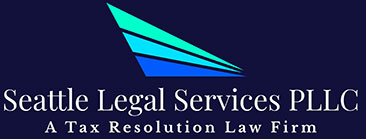
The IRS uses Form 433-F to gather information about taxpayer’s financial situations. You may need to file this form if you’re applying for a payment plan and cannot meet certain conditions. Additionally, in some cases, the IRS uses this form to establish financial hardship for people who want currently not collectible status on their accounts.
In most cases, the IRS will let you know if you need to file this form. Or a tax attorney may advise you to file this form based on the relief program you want. To help you out, here are tips and instructions. To get help now, contact us today at Seattle Legal Services, PLLC.
Why Do You Need to Complete Form 433-F?
You must complete Form 433-F to provide the IRS with information about your finances. The form is referred to as a collection information statement because it’s a statement the IRS uses to collect information about your finances. Then, the IRS uses this information to determine your eligibility for certain programs.
If you want to make monthly payments on your tax debt, you need to complete Form 433-F in the following situations:
- You cannot afford to make the minimum monthly payment to pay off your tax bill in 72 months. For example, imagine you owe $7,200, so your minimum monthly payments are $100, but you can only afford to pay $50. Then, the IRS will request this form.
- You owe over $25,000 and less than $50,000, but you don’t want the payments to come directly out of your bank account. In this case, you can avoid filing this form just by setting up direct debits with Form 433-D.
- You owe more than $50,000.
Note that as of 2023, the IRS’s instructions for Form 9465 (Installment Agreement Request) state that you must complete a collection information statement (CIS) if you owe over $50,000. However, other guidance released in this time frame indicates that you may only need to provide a CIS if you owe over $250,000 and/or if an IRS employee requests the statement.
Because IRS rules are constantly changing, you may want to contact a tax attorney for the most up-to-date guidance.
How to Complete Form 433-F
First, review the form to see which information you need. Although it’s only two pages long, it’s incredibly detailed, and it asks about all of your financial details. You may be able to complete this form online if you’re applying for a payment plan, but due to its detailed nature, you may want to start with notes. Then, you don’t have to worry about getting timed out.
Consider filling out the form on paper, and then, either file the paper or port the details to the online application.
Financial Information on form 433-F
Here is the information you need to complete this form. It consists of details about your income, expenses, assets, and debts.
- Bank accounts and lines of credit – Account number, type of account, and current balance of all bank, investment (CDs, mutual funds, stocks, bonds, etc), and crypto accounts and lines of credit. Include all accounts, even if they have a zero balance, but don’t list credit cards or bank loans in this section.
- Real estate – Details about all real estate, including current value, debt owed, and equity. Include insurance and taxes in the monthly payment amount if applicable.
- Other assets – All cars, RVs, boats, etc including their make, model, amount owed, and value. Also include other assets such as collectibles, antiques, and business assets.
- Credit cards – The balance due and total credit line of all credit cards, including cards that you no longer use but are still open.
- Business information – If you own a business, the total amount of accounts receivables owed to your business and details about merchant accounts for taking credit card payments.
- Employment information – If you or your spouse has a job, you must note your employer, length of time at the job, how often you are paid, and the taxes per pay period. Alternatively, attach pay stubs and skip this section.
- Other household income – The IRS wants to know about alimony, child support, self-employment income, rental income, pensions, dividends, Social Security, and any other payments that you get.
- Monthly living expenses – All expenses including food, personal care, transportation, housing, medical, and other bills such as child care, term life insurance, child support, and payments for delinquent state tax bills.
Note that the IRS takes state tax bills into account when determining how much you can afford to pay. In contrast, some states will not take IRS tax bills into account when determining your payment plans or settlements. Because of this, some tax attorneys recommend setting up payments on your state taxes before your federal taxes.
However, this varies based on the situation and the rules in your state. Contact a tax attorney before deciding the best path forward.
Actual Vs. Allowed Expenses
When completing the expenses portion of form 433-F, note that there are two columns. One is for actual expenses while the other is labeled allowed expenses. Sometimes, the allowed expenses part of the form will be filled out for you—for example, this may happen if a revenue officer is working your case and they start the form for you. However, in other cases, you or your attorney needs to fill out this part.
Allowed expenses refer to the amounts that the IRS believes people should be spending on necessary expenses. The IRS has national and local standards. national standards are expenses that tend to be the same everywhere in the country, such as food, housekeeping supplies, personal apparel and services, personal care products, and miscellaneous expenses. Local standards apply to expenses that vary a lot in different places, such as housing, utilities, and transportation.
For example, if you live in Los Angeles, the IRS assumes that you need to spend more on housing and transportation than someone who lives in rural Kentucky. The local standards are broken down fairly carefully. In a lot of cases, there are even different standards from county to county or in different parts of the same county.
What If Your Expenses Exceed the Allowed Amount?
Again, the IRS uses this information to determine how you should pay your tax bill. The agency has a few different responses to higher-than-allowed expenses, depending on the situation. Here’s a look at the most common scenarios.
When you cannot afford to pay the minimum monthly payment
Say that you’re using Form 433-F to apply for a payment plan with a lower-than-required monthly payment. In this case, the IRS will want to ensure that all of your disposable income goes toward your tax debt. If you have a lot of expenses that exceed the allowable amount, the IRS likely won’t accept your request. Instead, the agency will want you to reduce some of your expenses or sell your assets to pay off your tax debt.
However, the IRS does give you some wiggle room. If you only go over the allowed amount by a small amount, you may be able to attribute those extra expenses to the miscellaneous category. Similarly, if you have expenses that the IRS doesn’t normally take into account such as credit card bills, you can also put them into miscellaneous.
The six-year rule
The IRS will also allow you to go over the allowed amount if you can pay off the full balance within six years. For example, the six-year rule may come into play if you have to fill out From 433-F due to owing over $50,000 or because you owe over $25,000 and don’t want to set up direct debits.
In both of these cases, if you can pay off the full tax debt including interest and penalties in 72 months, the IRS doesn’t mind if you go over the allowed expenses.
Exceptional circumstances
For the most part, the IRS interprets the collection information statement (CIS) based on the numbers. However, there can be some areas of subjectivity. For example, you might have a medical reason or another valid reason for going over the allowed amount. If so, be prepared to explain why you need an exception for exceptional circumstances to the IRS.
Note that the IRS is focused on survival, not on comfort. So, you can argue that you need to pay higher utility bills due to having electrical medical equipment in your home. However, you won’t be able to argue that private school tuition or even college tuition is a necessary expense.
Work-related expenses
You can also get the IRS to not take certain work-related expenses or assets into account. For example, if you have a lot of equity in an asset and you are trying to establish currently not collectible status, the IRS may tell you to sell the asset and use the funds to pay your tax bill. However, if you can prove that you need the asset to earn income, the IRS may change its position. This same concept can also apply to certain expenses that exceed the usual allowable threshold.
Get Help With Form 433-F
Do you need to complete a collection information statement? Wondering if you should complete 433-F or another form in the 433 series such as the 433-A or 433-B? Then, we can provide the guidance you need.
Dealing with the IRS can be stressful and exhausting, but at Seattle Legal Services, PLLC, we have the experience you need. We can help you decide which forms to file, how to fill them out, and more. We can also help you set up the best resolution option for your unique situation.
To get help now, contact us today. We’ll start with a free consultation, and then, we’ll help you put your IRS or state tax problems to rest.
